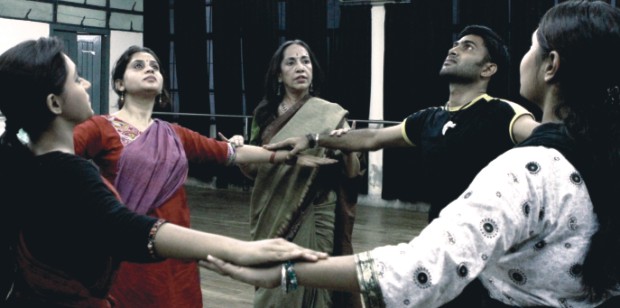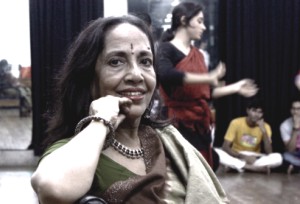| Home - Back Issues - The Team - Contact Us |
 |
| Volume 10 |Issue 17 | April 29, 2011 | |
|
|
Interview A Reticent Freedom Fighter Minu Haque tells the story of her passion that had led her to the most important event in her life– the War of Liberation. Tamanna Khan
The sound of music accompanied the rhythmic stomping flows into the small corner of Shilpakala's administrative building, where Minu Haque, a valiant freedom fighter, relates the story of her eventful life. A veteran of Bangladesh's cultural world, a renowned dancer specialising in the Odyssey form, vice president of Bangladesh's Dance Artist Association and executive member of International Theatre Institute, Bangladesh, Minu prefers keeping a low profile. Thus when young members of her group ask her in awe about her freedom fighter's role, she is not surprised. "They ask me why I have not told them earlier. But why should I? I am not going to publicise my role. I tell them it is your failure that even after 40 years of Independence you do not know that I am a freedom fighter," says Minu; yet another women freedom fighter whose contribution like many others went unrecognised. Minu grew up in a middle-class Muslim family, but her father Meter Billah and mother Mina Billah never opposed their eight children's cultural affinity. "Abba taught us namaj, Koran recitation, made us fast; at the same time we also learned singing and dancing. He never told us what to do and what not to do," Minu says. Her youngest sister, Shimul Yusuf is one of the most prominent theatre activists of Bangladesh. Minu's elder sister, Sarah Mahmud, was married to Shaheed Altaf Mahmud, the famous composer of "Aamar Bhaiyer Rokte Rangano"- the song of our language movement. Reflecting on the harmony of religious and cultural practise of her childhood days, she says, "We had a lot of Hindu and Christian neighbours and friends. At that time, the schools were closed for 30 days starting from first Ramadan. We used to bring out our bed in the yard, make stage with our mothers' sari, write scripts and perform plays and dance. Then all of us would take Iftar together." Although Minu started with lessons on classical songs from PC Gomes, later she moved on to dance at the age of six. She says, "Dulal Talukdar, a prominent dancer at Bulbul Academy, was our neighbour. We used to go to his house to eat boroi (local plum). He taught me dancing. He was my first guru." Later Minu took admission at Bulbul Lalit Kala Academy Bangladesh and received her certificate in 1972.
What inspired her to become a dancer? She provides an astonishing answer– nature. The quaint Dhaka of her childhood with trees and ponds made her a nature lover and a close observer. "I grew up with nature; its inbuilt rhythm inspires me," she says, "The more you see nature the more expression you can give. If you do not understand nature you cannot dance." Showing the delicate mudra (dance signs) for flowers and buds, Minu explains how interaction with nature develops a dance artiste. Among the prominent dance artist Minu likes Madhavi Mudgal's classical and Leela Samson's Bharatnatyam. Yet she feels there is always something to learn from every single artiste. After completing her matriculation in 1968 from Motijheel Girl's High School, Minu took admission at honours at Dhaka University's Psychology department. But her freshman year ended on March 7, 1971. On the evening of March 25, Minu and her siblings, along with Altaf Mahmud and his friends, were playing indoor games at the veranda of their Rajarbagh house when a rickshaw puller passed by shouting 'Pakistan Army has raided Iqbal Hall! Pakistan Army is coming!' Soon she heard commotion at the police line. Policemen who had revolted against the army were taking positions in the rooftops of the neighbouring houses. "Throughout the night they fought with the army. Large shells hit our house. My brother-in-law gathered us all in the bathroom and put layers of wet quilts and mattresses because we could not breathe (due to the heat). They (Pakistani Army) were using petrol for blazing (the police line)," Minu shudders at the memory of the fateful night even after 40 years. Following March 25, she and her family began to lead a fugitive life taking shelter sometimes at family friends' houses or at Buddhist temples. "We went to the Buddhist temple in the morning of March 27. Vishuddhananda Mahathero gave us shelter for one whole month," states Minu with gratitude. In the meantime, to impose normality, Tikka Khan announced the educational institute open and ordered students to attend classes. Similarly, television artistes were summoned to entertain the Pakistani Army. Minu, an enlisted artist of Nritter Taley Taley, a dance programme for young viewers, was not spared. Soon Pakistan Army came to enquire about her and her mother faced the questioning. "My mother was a very brave lady. She told them that I had gone to our village for summer vacation. But they told her to bring me back and that they would come again," recalls Minu. They did come four times. "Things went out of hand when some of my friends who used to dance with me and went to the cantonment for dancing, told them that we supported the Muktis. We did not support Pakistan," she says. After that Minu's mother sent her to Sufia Kamal's house. Her daughters Sultana and Syeda Kamal were already at the front and they wanted Minu with them. At that time, Altaf Mahmud was also getting ready to take his recordings to Shadhin Bangla Betar Kendra. Minu's mother implored him to take Minu along to save her from the hands of the Pakistani soldiers. "Just a day before our departure, Altaf bhai told Amma that he cannot go. But she could send me with freedom fighters, Shahadat Chowdhury of Bichitra and Habibul Alam, Bir Pratik," recalls Minu. Tears glisten in her eyes as she relates how only a day after Altaf Mahmud along with Jewel, Bodi, Rumi and Azad were arrested by the Pakistani Army. "Had dulabhai come along with me that day, he would not have to give up his life like this," Minu mutters in a broken voice. The journey from Dhaka to Agartala beats even war-movies in Minu's opinion. "I did not know where I was going. We were crossing rivers with other refugees whilst bullets ran over our heads. There were Pakistani searchlights at the CNB road of Comilla. A Bengali razakar was standing there. He advised us to mention the name of a place in Comilla if asked. While crossing the river we saw an army van passing the razakar and asking him something. He had told us not to worry about him. 'I will give my life (if required)' he had promised." Minu did safely cross over to Agartala and went to the only field hospital of Bangladesh there. "It was like heaven built between two hillocks in acres of land. Everything - the OT, the medical ward, the patient's ward, surgical ward, and women's dormitory- was made of bamboo," recounts Minu. The owner, she says was a rich businessman Habul Banerjee who gave up his entire business property – gardens of cashew nuts, pineapple, guava and banana– to the Bangladesh government. "The hospital was under Khaled Mosharraf's Sector-2. Captain Akhter taught us how to use the injection, measure pulse and blood pressure; the rules were very strict. Many of the injured were young village farmers. Once a boy with bullet injuries came and we took him to our OT covered from all sides with only polythene. Akhter bhai told me to hold the wound area if I didn't feel nervous. He then brought out a bullet with a blade. I never felt nervous or afraid there. We would get up and run to the ambulances even at the dead of night. I stayed there till December, when the need for trained nurses rose, after the official war between India and Pakistan broke out," recollects Minu proudly. Participation in the Liberation War of Bangladesh brought her honours like the reception by the Eastern Command of India on December 16, 2009. "They arranged a lunch named Baraikhana, which only army men could board. I was the only woman freedom fighter among the 1,700 army men present there," she says. In her view, her mother should be given credit for her participation in the war. "People always talk about mothers sending their sons to the war. But my mother had sent her daughter to the war." After Liberation, Minu continued to pursue her passion. First she took Manipuri lessons from Shantibala Devi and then Odyssey lessons from Sunny Mahapatra and Ipshita Behara. "I chose Odyssey because it was a comparatively new form and later I used this knowledge in life," she says. Minu named her school after a main item of Odyssey – Pallavi Dance Centre. "The status of dance in Bangladesh is good. There are lots of talents but no sponsors like India. Many of our artistes become frustrated and move on to acting or modelling. Why won't they go? You need money. Dancing is very expensive. But everyone wants us to do it for free." She complains. Minu particularly criticises the electronic media for not promoting dance and forcing artistes to do commercial works. "Students today lack dedication. Although they are talented they lack commitment," she adds. However, Minu is not someone who would give up amongst negativities. "We at Nrittya Shilpi Shangstha want to spread dance to all corners of the country even at madrasas. A piece of good news is that our attempt to open a dance department at Dhaka University is almost complete. It only awaits a signature but I heard that the man whose signature is needed is an extremist," she informs. She says that her attempt to include dance as compulsory or optional subject in the educational policy has failed because of the presence of fundamentalists elements even at the education board. "At the committee they told us, 'Why are you trying to put yet another Hindu item?' Many people think Kathak is a Muslim form of dance only because the dancer sometimes covers her head. Actually Katthak is all about Radha- Krishna's love," she says. She says that there is no research to promote and preserve folk dances like Dhamail dance of Sylhet and Santal dance of North Bengal. Minu nurtures a small dream – a dance school for underprivileged children who will live there and learn dancing along with other subjects, which will include even religion. "All I need is a small piece of land. When Pratima Devi established Nrittyagram in India many billionaires sponsored her. Will anyone help me? I ask the nation – is it possible?" asks the reticent freedom fighter, as shadows of the setting sun plays in her dreamy eyes.
Copyright
(R) thedailystar.net 2011 |
||

